Structure Comparision
Context
- The Structure Comparison window is a key element of the Structural Coefficient Analysis, from where it can be launched.
Usage
-
You can open the **Structure Comparison window** by clicking the Structure Comparison button at the bottom of the **Structural Coefficient Analysis Report**.
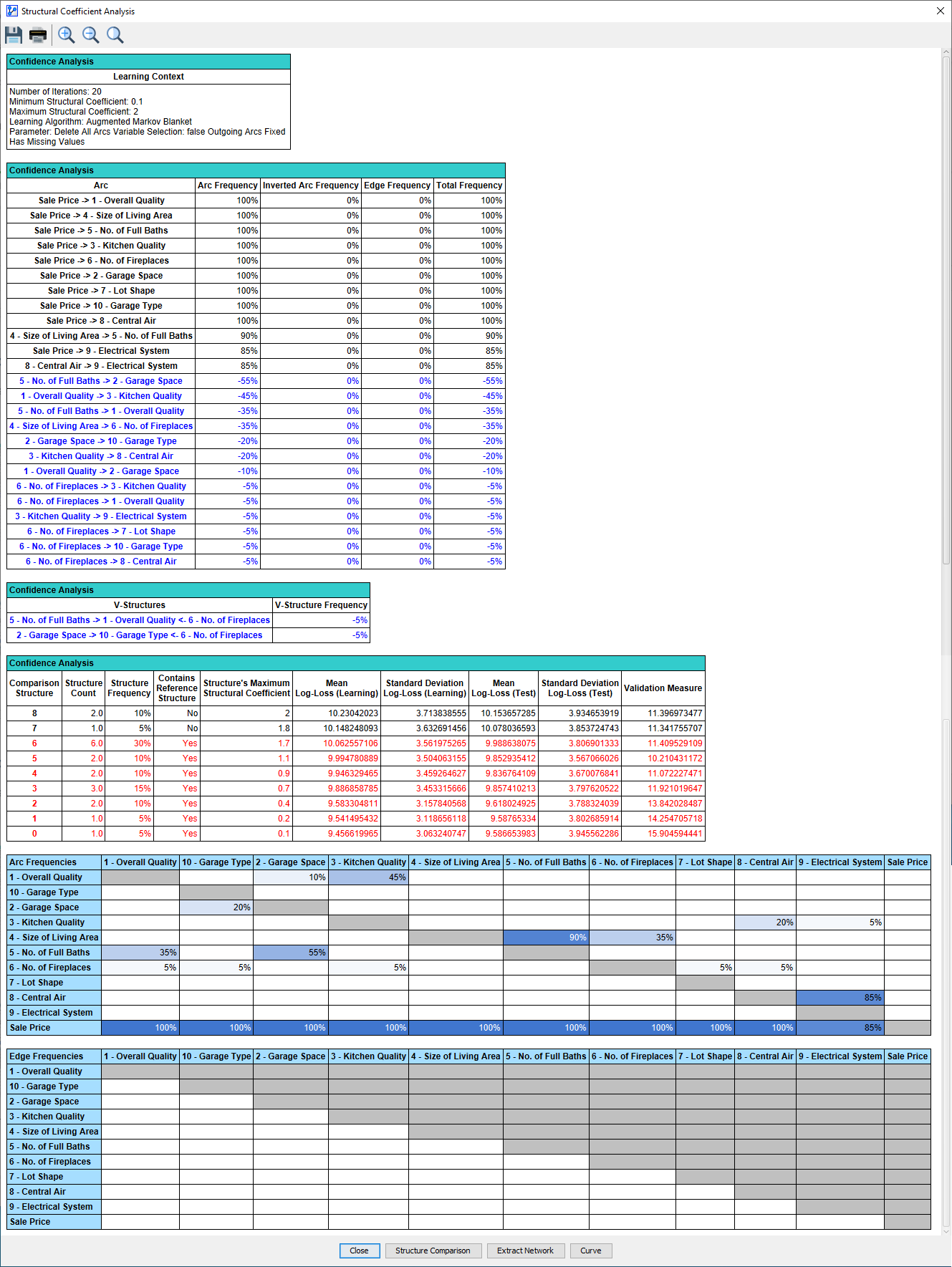
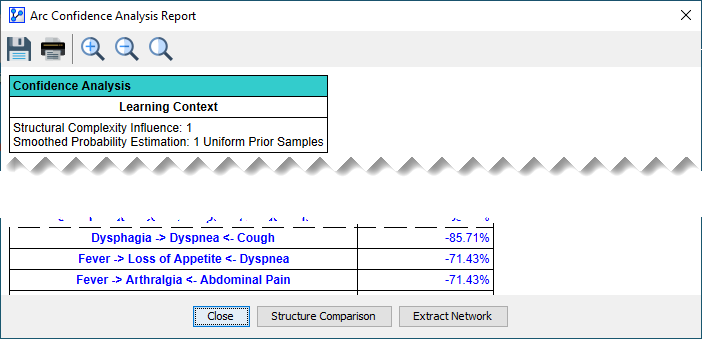
Structure Comparison Window
- The Structure Comparison window is not exclusive to the Structural Coefficient Analysis. It is also available in a similar form in the context of other learning processes that produce a variety of Bayesian networks for comparison and evaluation purposes.
- The Structure Comparison window features a toolbar at the top. Some of the icons are common throughout BayesiaLab and others are specific to this particular context:
Save the currently displayed graph as an image file | |
Print the currently displayed graph | |
Show the Synthesis Structure | |
Show the Reference Structure | |
| Go to the previous structure | |
| Go to the next structure | |
| Zoom In | |
| Zoom Out | |
Return to the Default Zoom Level | |
Resize the graph to fit the window | |
Position the graph at the top-left corner of the window | |
Stretch the graph or the selected nodes | |
Shrink the graph or the selected nodes | |
| Rotate Left | |
| Rotate Right | |
Save currently displayed network as an XBL file | |
Open currently displayed in a new Graph Window |
Synthesis Structure
-
Upon opening the Structure Comparison window, the Synthesis Structure appears as the default view.
-
The Synthesis Structure is marked by the icon in the toolbar and also labeled as such at the bottom of the Structure Comparison window.

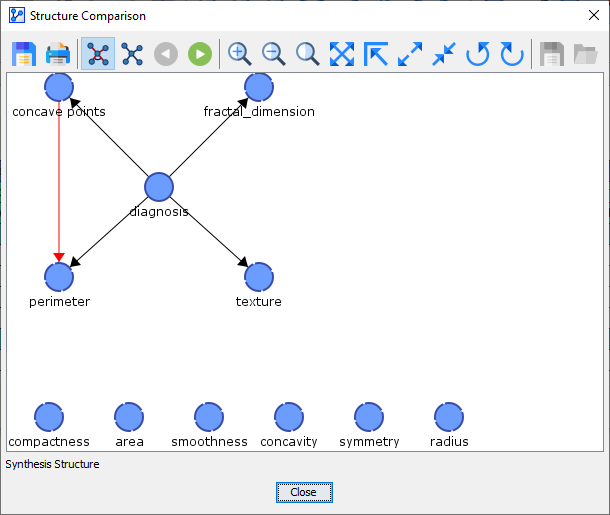
-
Although the Synthesis Structure may look like a Bayesian network, it is actually not a Bayesian network.
-
Rather, the Synthesis Structure visualizes the commonalities and differences between the Reference Network and the Comparison Networks.
- A black edge or arc signifies that it exists both in the Reference Network and all Comparison Networks.
- A blue edge or arc indicates that it does not exist in the Reference Network but that it does exist in at least one of the Comparison Networks.
- A red edge or arc means that it does exist in the Reference Network but that it does not exist in any of the Comparison Networks.
-
Arcs are displayed in the form of an arrow, while edges are shown as a straight solid line.
-
A circle line between two arcs highlights a V-structure.
-
The thickness of a line between two nodes is proportional to the frequency of the corresponding edge or arc, i.e., a thick blue arc implies that that arc occurs frequently in the Comparison Networks.
-
By hovering over an arc or an edge in the Synthesis Structure, tooltips provide you with details regarding the object properties, as illustrated below.

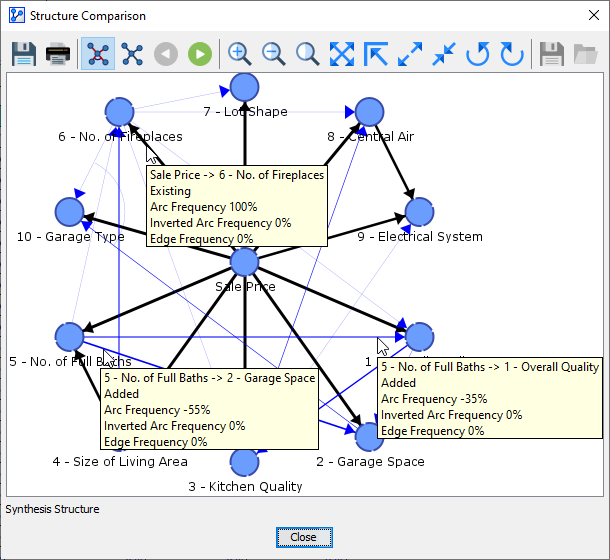
- Examples from the Synthesis Structure: - 5 - No. of Full Baths -> 2 - Garage Space - ”->” between the node names means that the link, whenever it is present in any structure, is always a directed arc from 5 - No. of Full Baths to 2 - Garage Space. - “Added” means that this link does not exist in the Reference Structure but in at least one of the Comparison Structures. - “Arc Frequency -55%” means that in 11 out of 20 **Comparison **Structures****, the link was a directed arc from 5 - No. of Full Baths to 2 - Garage Space. - “Inverted Arc Frequency 0%” means that none of the **Comparison **Structures**** contained the inverted arc, i.e., 2 - Garage Space to 5 - No. of Full Baths. - “Edge Frequency 0%” means that in none of the **Comparison **Structures****, there was an undirected edge between 5 - No. of Full Baths and 2 - Garage Space. - Sale Price -> 6 - No. of Fireplaces - ”->” between the node names means that the link, whenever it is present in any structure, is always a directed arc from Sale Price to 6 - No. of Fireplaces. - “Existing” means that this link exists in the Reference Structure and all the Comparison Structures. - “Arc Frequency 100%” means that in all 20 **Comparison * *Structures****, the link was a directed arc from Sale Price to 6 - No. of Fireplaces. - “Inverted Arc Frequency 0%” means that none of the **Comparison **Structures**** contained the inverted arc, i.e., 6 - No. of Fireplaces to Sale Price. - “Edge Frequency 0%” means that in none of the **Comparison **Structures****, there was an undirected edge between Sale Price and 6 - No. of Fireplaces. - 5 - No. of Full Baths -> 1 - Overall Quality - ”->” between the node names means that the link, whenever it is present in any structure, is always a directed arc from 5 - No. of Full Baths to 1 - Overall Quality. - “Added” means that this link does not exist in the Reference Structure but in at least one of the Comparison Structures. - “Arc Frequency -35%” means that in 7 out of 20 **Comparison **Structures****, the link was a directed arc from 5 - No. of Full Baths to 1 - Overall Quality. - “Inverted Arc Frequency 0%” means that none of the **Comparison **Structures**** contained the inverted arc, i.e., 1 - Overall Quality to 5 - No. of Full Baths. - “Edge Frequency 0%” means that in none of the **Comparison **Structures****, there was an undirected edge between 5 - No. of Full Baths and 1 - Overall Quality.
Reference Structure
-
By clicking on the next button , you proceed from the Synthesis Structure to the Reference Structure.
-
Alternatively, you can access the Reference Structure by clicking on the corresponding icon .

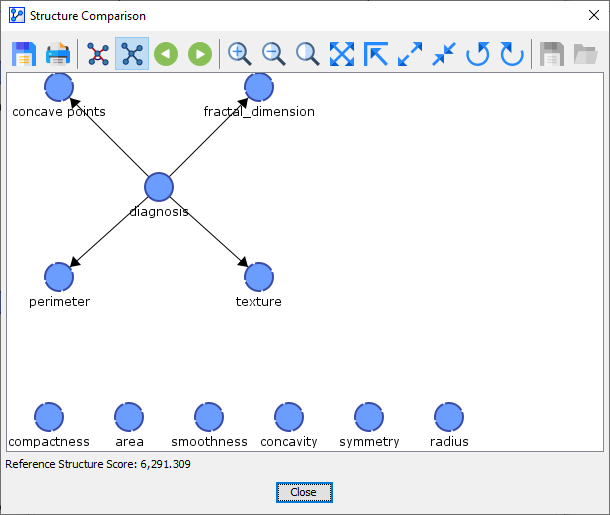
-
The Reference Structure represents the original network. Thus, what is displayed is a proper Bayesian network, not merely an illustration.
Comparison Structures
-
By clicking on the next button , you proceed from the Reference Structure to the first of potentially many Comparison Structures.

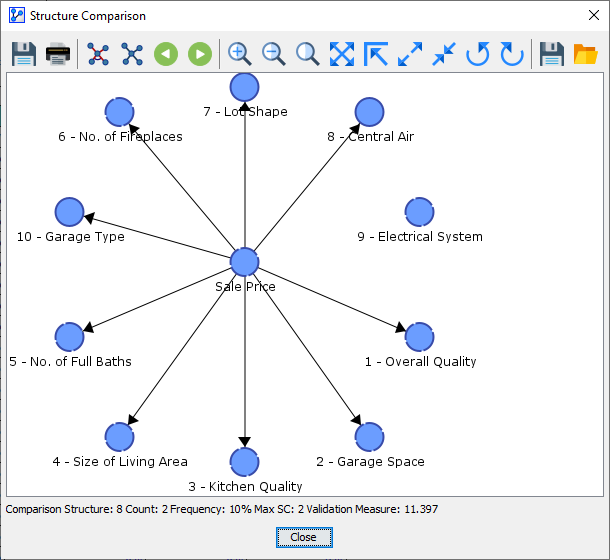
-
The first one is labeled as “Comparison Structure: 8” at the bottom of the window.
-
You can use the previous and next buttons to navigate through the available structures in this order:
- Synthesis Structure, i.e., the illustration of the differences between the Reference Network and the Comparison Networks.
- Reference Structure, i.e., the starting point of the analysis that produced all Comparison Networks.
- Comparison Structure 8
- Comparison Structure 7
- Comparison Structure 6
- etc.
-
Right underneath the graph area, BayesiaLab reports additional information regarding the displayed Comparison Structure:
- The sequence number, e.g, 8, 7, … 0.
- The Count, i.e., the number of times the displayed Comparison Structure was found. In the above screenshot, the shown Comparison Structure was found twice.
- The Frequency, which refers to the count of the displayed Comparison Structures divided by the count of all generated Comparison Structures. Here, the Frequency is 10% (=2/20 displayed in percent). Note that the total number of Comparison Structures is not displayed here.
- The Max SC, which represents the Structural Coefficient used for learning the displayed Comparison Structure.
- The Validation Measure, which serves as a quality measure for choosing an appropriate Structural Coefficient.
-
For Comparison Structures, the Save Network and Open Network icons are available. This allows you to extract the currently displayed Comparison Structure.
-
The following table provides a side-by-side comparison of all structures. Click on the thumbnails to see full-size screenshots.
| Synthesis Structure | Reference Structure | Comparison Structure 8 | Comparison Structure 7 | Comparison Structure 6 | Comparison Structure 5 | Comparison Structure 4 | Comparison Structure 3 | Comparison Structure 2 | Comparison Structure 1 | Comparison Structure 0 |
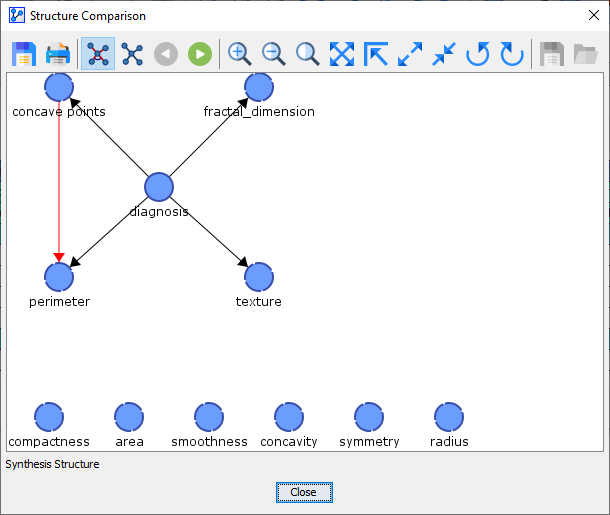 | 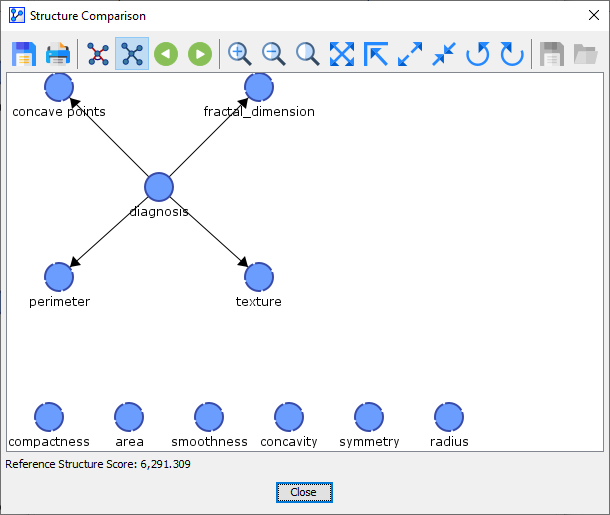 | 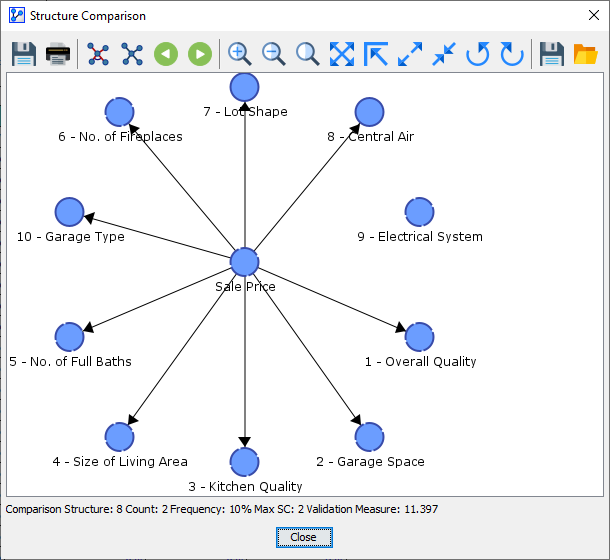 | 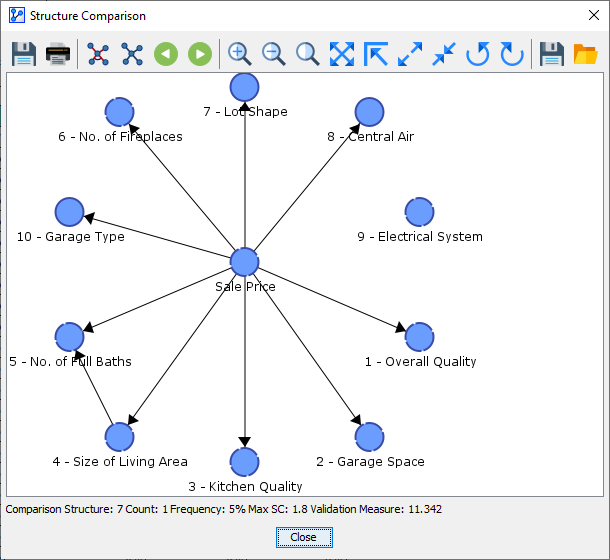 | 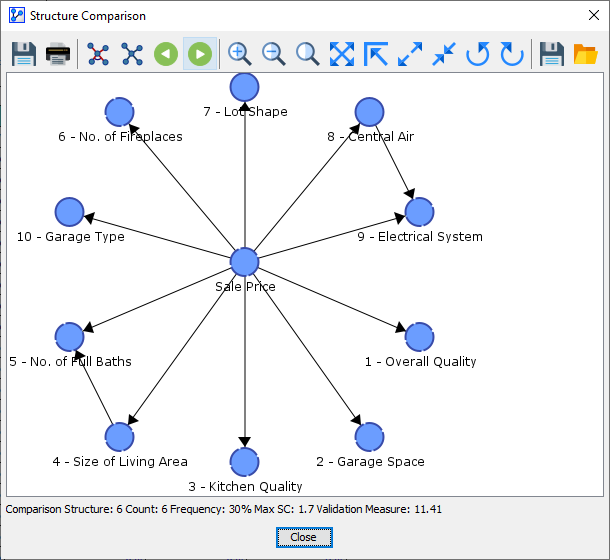 | 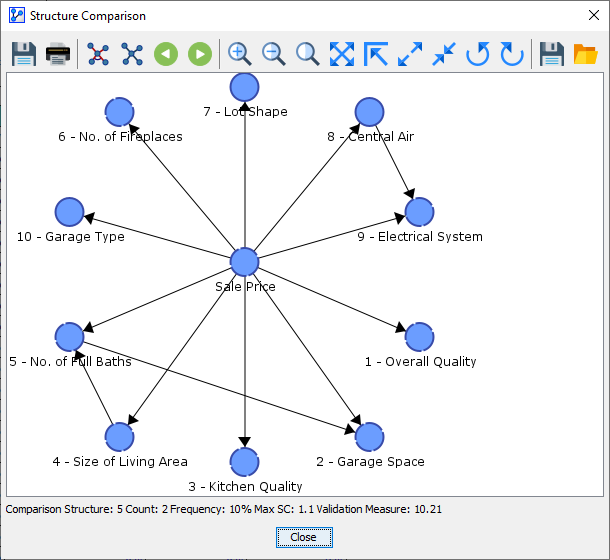 | 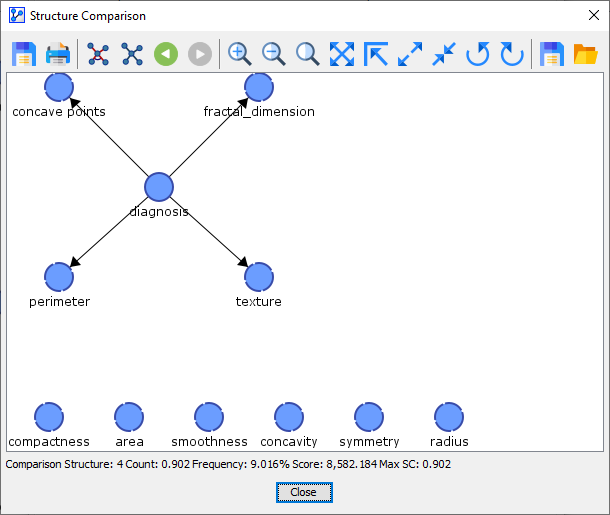 | 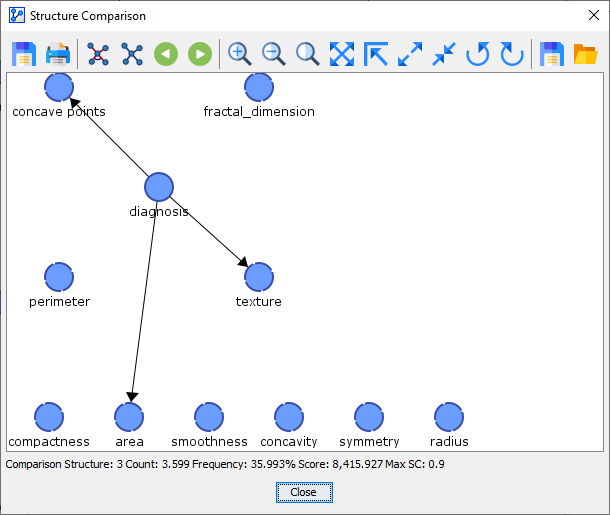 | 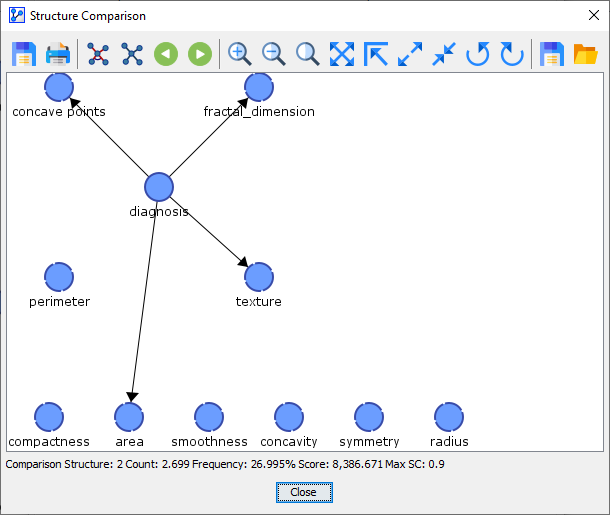 | 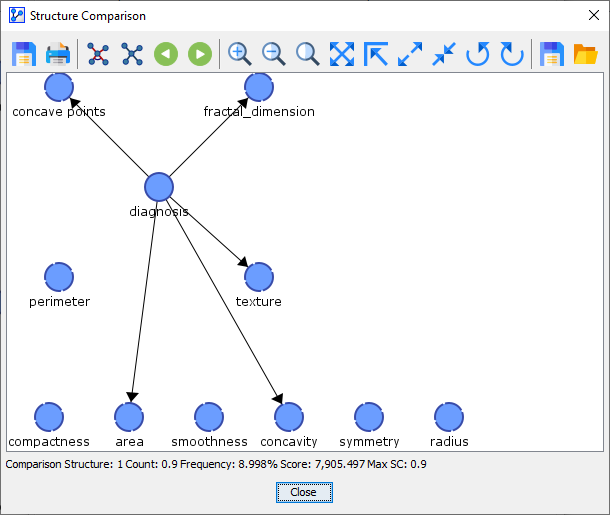 |  |
| Count: 2 | Count: 1 | Count: 6 | Count: 2 | Count: 2 | Count: 3 | Count: 2 | Count: 1 | Count: 1 | ||
| Frequency: 10% | Frequency: 5% | Frequency: 30% | Frequency: 10% | Frequency: 10% | Frequency: 15% | Frequency: 10% | Frequency: 5% | Frequency: 5% | ||
| Max. SC: 2 | Max. SC: 1.8 | Max. SC: 1.7 | Max. SC: 1.1 | Max. SC: 0.9 | Max. SC: 0.7 | Max. SC: 0.4 | Max. SC: 0.2 | Max. SC: 0.1 | ||
| Validation Measure: 11.397 | Validation Measure: 11.342 | Validation Measure: 11.41 | Validation Measure: 10.21 | Validation Measure: 11.072 | Validation Measure: 11.921 | Validation Measure: 13.842 | Validation Measure: 14.255 | Validation Measure: 17.056 |
